Welcome to Ubud, Bali’s serene and culturally rich heartland! As an experienced traveler, I’ve discovered that Ubud is a treasure trove of spiritual heritage, housing some of the most fascinating and beautiful temples in the world. Each temple, with its unique architecture and mystical ambiance, tells a story of Bali’s deep-rooted traditions and religious practices. Whether you’re seeking spiritual enlightenment, architectural marvels, or just a peaceful retreat into nature, Ubud’s temples offer an unforgettable journey. Let’s explore these sacred spaces together, immersing ourselves in the tranquility and beauty that make Ubud truly special.
Saraswati Temple
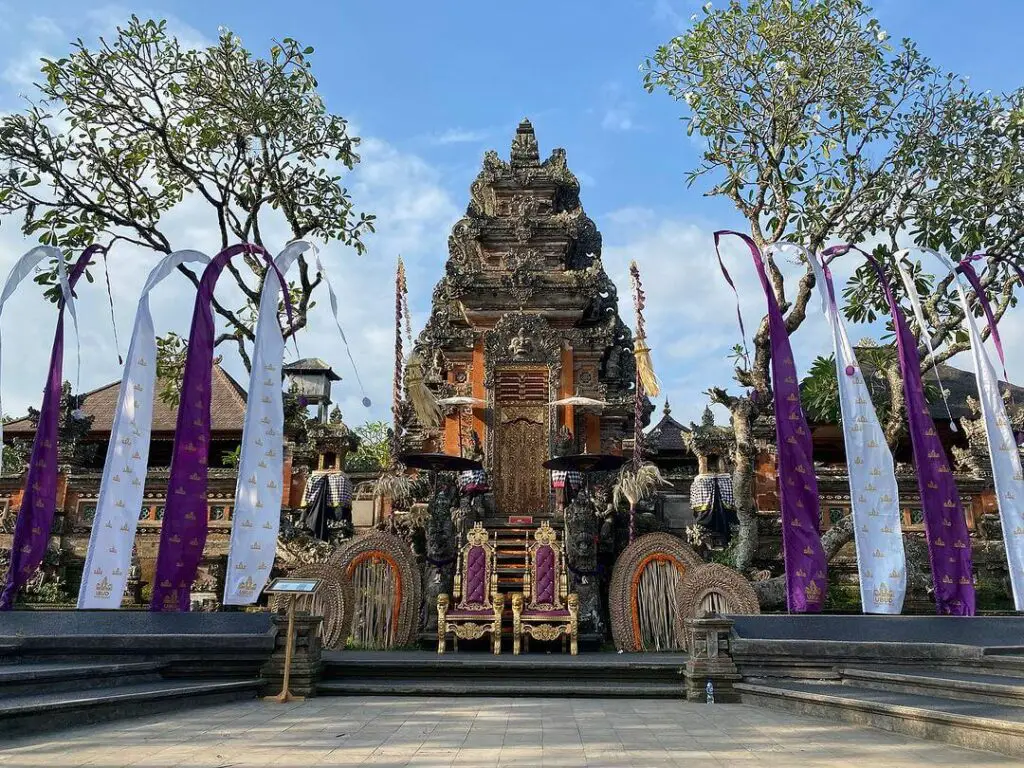
Location: https://maps.app.goo.gl/Bv6jmi2fSkHTxKQy5
In the heart of Ubud lies the enchanting Saraswati Temple, a tribute to the goddess of knowledge and arts in Hindu mythology. Conceived by the legendary Balinese architect, I Gusti Nyoman Lempad, this temple was brought to life in the 1950s under the patronage of local royalty. More than a place of worship, it’s a celebration of Bali’s rich artistic tradition, adorned with exquisite carvings and sculptures crafted by skilled artisans.
Its most captivating feature is a tranquil lotus pond, bordered by fragrant frangipani trees and detailed water gardens. A beautifully ornamented bridge, guarded by statues, leads to the temple’s majestic main entrance, offering a serene yet profound experience that encapsulates the essence of Balinese culture and spirituality.
Pura Dalem Temple

Location: https://maps.app.goo.gl/i8xTqr64y1NfHv8R7
The Pura Dalem Temple in Ubud is a striking embodiment of Bali’s deep spiritual and cultural roots. Known for its intricate and somewhat mysterious statues, the temple radiates an aura of mystique. Often associated with darker elements of Balinese Hinduism, it is dedicated to Durga, the goddess of death and regeneration, reflecting the Balinese belief in the dual nature of existence.
Surrounded by dense foliage, the temple’s architecture is a blend of traditional Balinese and Hindu styles, featuring elaborate carvings and a serene atmosphere despite its association with the supernatural. The temple grounds are often quieter, offering a more introspective experience compared to the more frequented sites in Ubud.
Visitors are greeted by a variety of statues, ranging from protective guardians to figures from Hindu mythology, each telling a story of faith, mythology, and the island’s rich history. The Pura Dalem Temple is not just a place of worship, but a gateway to understanding the complex tapestry of Balinese culture and its reverence for the cycles of life and death.
Sacred Monkey Forest Sanctuary
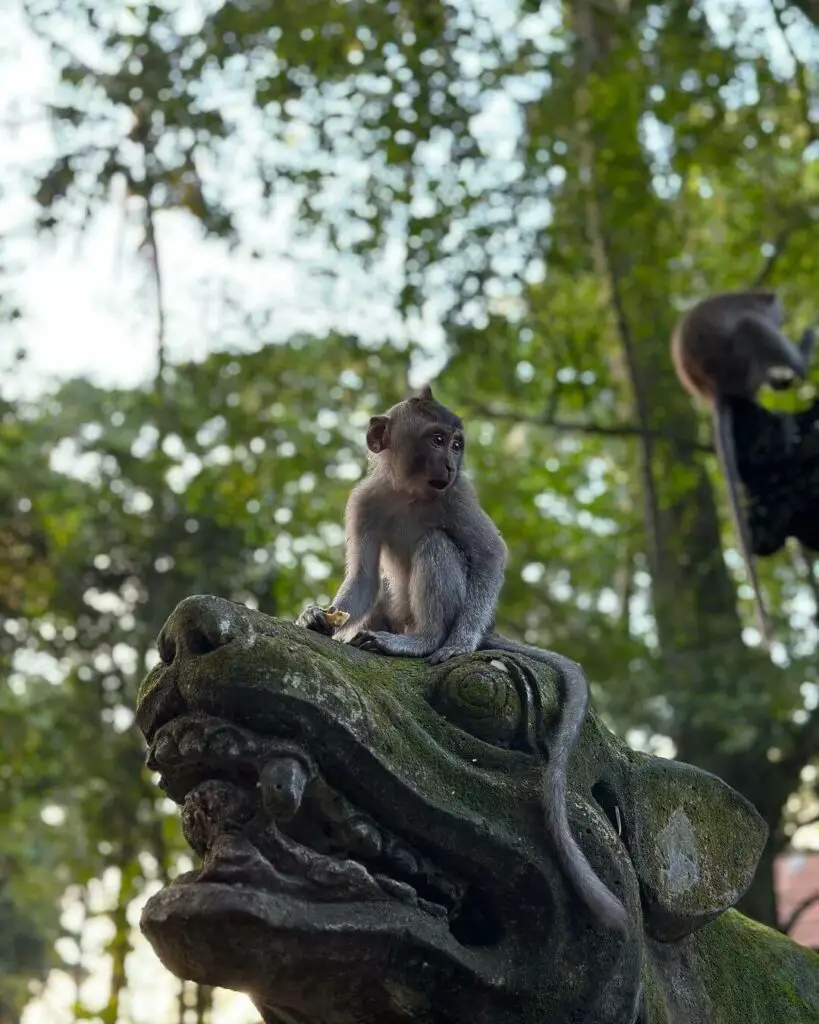
Location: https://maps.app.goo.gl/soen9H4oLVRN3KLXA
The Sacred Monkey Forest Sanctuary in Ubud is a unique blend of natural wonder and cultural significance. This lush forest sanctuary is home to hundreds of playful long-tailed macaques, and amidst the dense foliage lie ancient temples shrouded in mystery. The main temple, Pura Dalem Agung Padangtegal, thought to be built around 1350 AD, stands as a testament to the sanctuary’s historical and spiritual significance.
As you wander through the forest, the sounds of the monkeys and the rustling leaves create an atmosphere of an otherworldly realm. The statues and relics scattered throughout the sanctuary add to the mystical ambiance, inviting visitors to ponder the rich spiritual heritage of Ubud. The Monkey Forest is not just an ecological haven; it’s a journey into the heart of Balinese tradition, where nature and spirituality intertwine seamlessly.
Ubud Palace

Location: https://maps.app.goo.gl/eMJhALxPEYjJLarK9
Ubud Palace, or Puri Saren Agung, is a historical and cultural landmark in the heart of Ubud. Built in the 1800s, it was the royal residence of the Ubud royal family and remains a stunning example of traditional Balinese architecture. The palace is renowned for its intricate design, detailed carvings, and beautiful garden settings, embodying the artistic and cultural ethos of the region.
The palace serves not only as a historical site but also as a vibrant venue for cultural performances, particularly traditional Balinese dances, which are held in the evenings. These performances, set against the backdrop of the majestic palace, provide an enchanting glimpse into the rich heritage of Bali.
Visitors to Ubud Palace are treated to a visual feast of ornate structures and a palpable sense of history. The palace’s central location makes it a focal point in Ubud, easily accessible and an essential stop for anyone seeking to immerse themselves in the authentic Balinese experience.
Goa Gajah Temple

Location: https://maps.app.goo.gl/3j3Aqqe3u7hxvN2C8
Goa Gajah Temple, often referred to as the Elephant Cave Temple, is a remarkable archaeological site near Ubud that offers a glimpse into Bali’s historical and spiritual past. This 9th-century temple is renowned for its unique cave entrance, an intricately carved façade featuring menacing creatures and demons, which leads into a dark, narrow passage.
Inside, the cave houses a meditation space and several relics, adding to the site’s mystical aura. The complex outside the cave is equally fascinating, featuring bathing pools with fountains that date back to the 11th century, showcasing the temple’s role in ritual purification.
Surrounded by lush rice fields and a tranquil river, Goa Gajah Temple is not just a historical site but a spiritual sanctuary that resonates with the peace and serenity characteristic of Balinese Hinduism. Its unique blend of history, architecture, and spirituality makes it an essential destination for those exploring the rich tapestry of culture in Ubud.
Samuan Tiga Temple
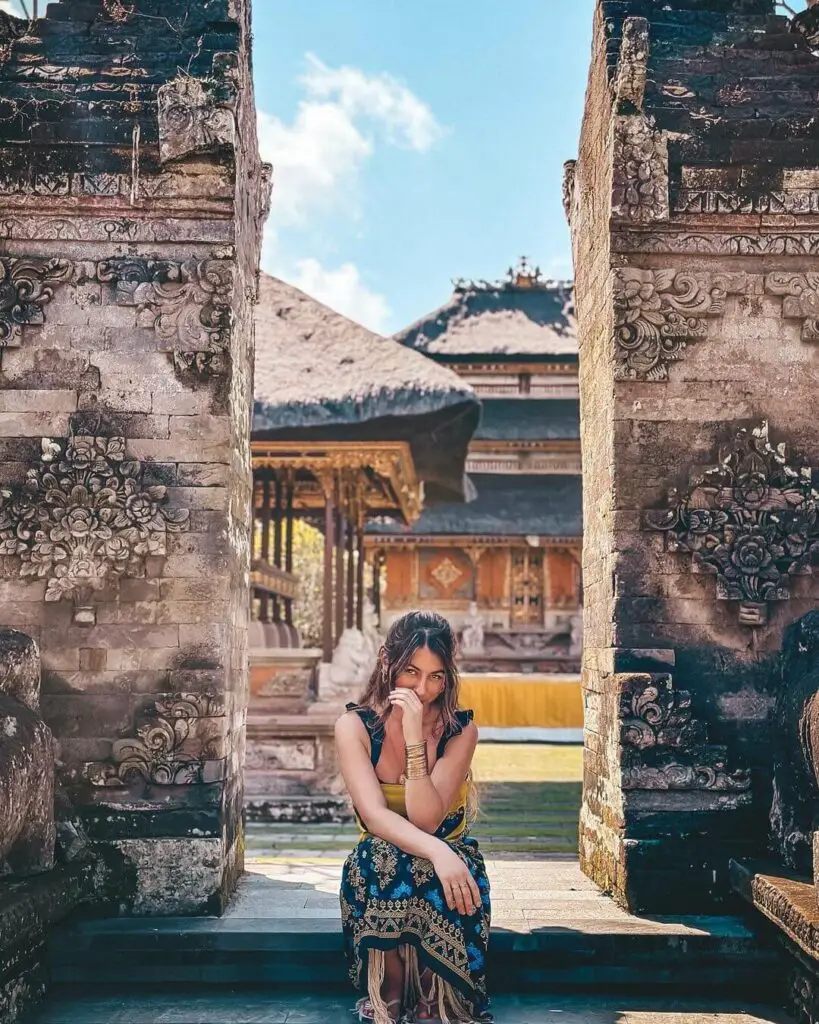
Location: https://maps.app.goo.gl/NjcqTve1fz7Wt3FZ9
Samuan Tiga Temple, a hidden gem located between Ubud and Gianyar, is a significant yet serene spiritual site steeped in Bali’s history. Dating back to the 10th century, this temple stands as a testament to the island’s rich religious traditions and architectural heritage. It is renowned for its role in the reconciliation of rival kingdoms, symbolizing unity and peace in Balinese Hinduism.
The temple’s architecture is a harmonious blend of ancient and medieval Balinese styles, featuring several courtyards and intricately carved gates that lead to tranquil inner sanctuaries. Despite its historical significance, Samuan Tiga remains a peaceful retreat, often overlooked by the tourist crowds. Its quiet, reflective atmosphere, combined with its lush surroundings, offers a unique and authentic spiritual experience away from the bustling streets of Ubud.
Goa Garba
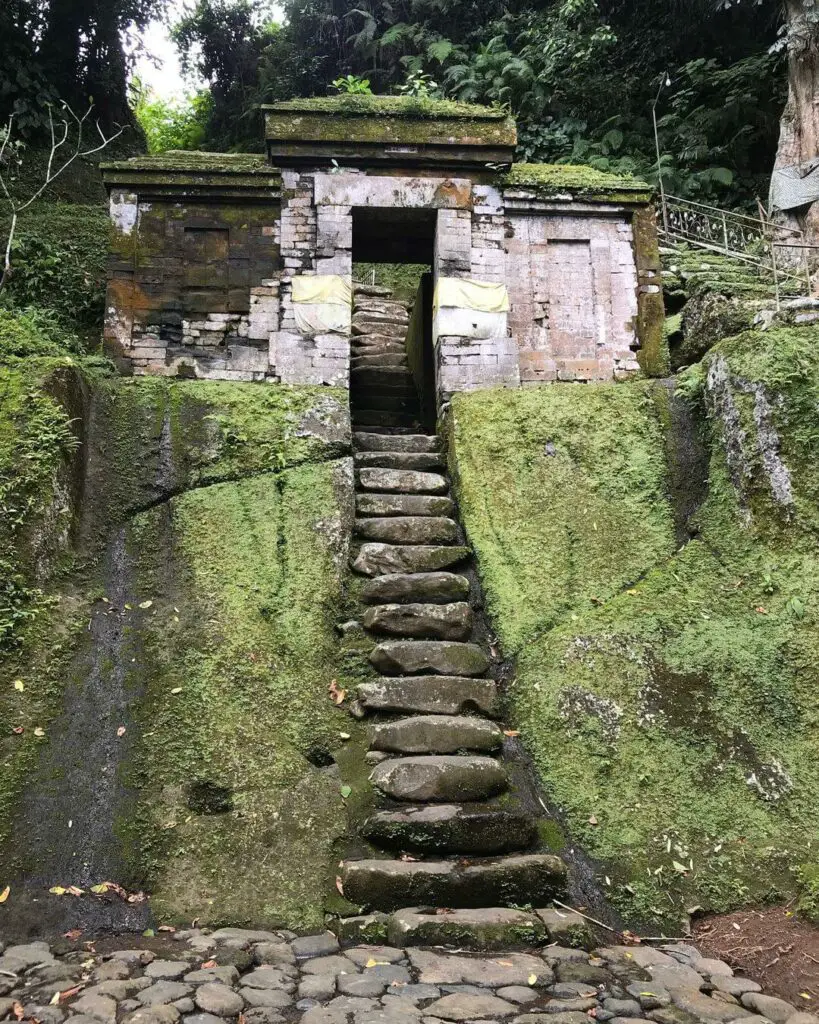
Location: https://maps.app.goo.gl/xxAboR8NStonmXZs6
Goa Garba, nestled in the village of Pejeng near Ubud, is a captivating ancient cave temple and archaeological site dating back to the 12th century. This hidden jewel of Bali was historically a center of learning and spiritual practice for Balinese kings and their progeny. Today, it stands as a serene and somewhat secluded retreat, offering visitors a chance to explore Bali’s rich history away from the usual tourist trails.
The temple’s ruins, set amidst dense jungle, provide a fascinating glimpse into Bali’s past. The peaceful ambiance of Goa Garba, combined with its historical significance, makes it an ideal spot for those seeking a deeper understanding of Balinese culture and history. Its relative obscurity adds to its charm, offering a unique and tranquil experience for visitors.
Candi Tebing Gunung Kawi

Location: https://maps.app.goo.gl/y9in25WLZhVVvKy47
Candi Tebing Gunung Kawi, located near Ubud, is an extraordinary archaeological site that captures the essence of Bali’s ancient history and spiritual heritage. This 11th-century temple complex is renowned for its ten rock-cut shrines, each standing at seven meters tall, carved into the face of a cliff. These shrines are believed to be memorials to members of the Balinese royal family, making Gunung Kawi a site of significant historical and cultural importance.
The temple is set in a verdant valley, with the Pakerisan River flowing gently beside it, adding to the serene and mystical atmosphere. Visitors descend a series of steps to reach the temple, passing through lush rice terraces and tropical foliage. The combination of its stunning natural setting, awe-inspiring ancient architecture, and the peaceful ambience makes Candi Tebing Gunung Kawi a must-visit for those interested in Bali’s rich past and the tranquility of its landscapes.
Pura Gunung Kawi Sebatu

Location: https://maps.app.goo.gl/EG86kVBT6g5RpNqJA
Pura Gunung Kawi Sebatu, a lesser-known but equally enchanting temple near Ubud, offers a tranquil and spiritual experience amidst lush greenery. This water temple, dedicated to Vishnu, the Hindu god of water, is revered for its holy springs and serene lotus ponds, which are believed to have purifying properties. The temple’s setting in a tranquil jungle, with its natural springs and water features, creates an atmosphere of peace and spiritual rejuvenation.
The architecture of Pura Gunung Kawi Sebatu is a beautiful representation of Balinese style, with intricately carved stone and detailed statues. The temple’s serene environment, combined with the gentle sound of flowing water, provides a perfect backdrop for meditation and reflection. It’s a place that remains relatively undisturbed by the bustling tourist scene, offering visitors a more intimate glimpse into the spiritual practices of Bali.
Tirta Empul Temple
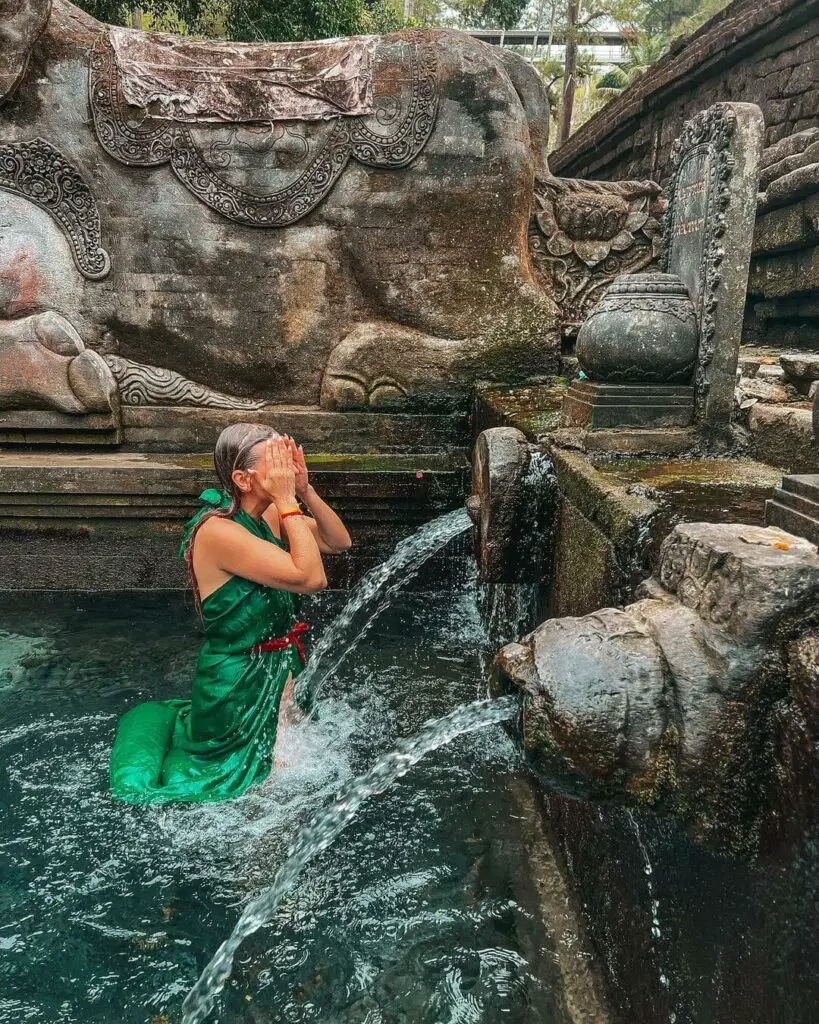
Location: https://maps.app.goo.gl/6RVuJvnyxYAJt1Pa9
Tirta Empul Temple, located near Ubud, is a site of profound spiritual significance and natural beauty. Known for its sacred spring water, this temple is a major draw for both locals and tourists seeking purification and healing. According to legend, the springs were created by the god Indra and possess curative properties. This belief draws many to partake in the ritual of water purification, which involves bathing in the temple’s holy waters.
Built around 962 A.D., Tirta Empul is a stunning example of traditional Balinese temple architecture, featuring two main courtyards and a large rectangular pool fed by the sacred spring. The temple is not just a place of spiritual cleansing but also a cultural treasure, reflecting the deep connection between Balinese Hinduism and the natural world. The serene and spiritual atmosphere at Tirta Empul offers a unique and enriching experience, deeply rooted in the island’s cultural and religious traditions.
Beji Griya Waterfall
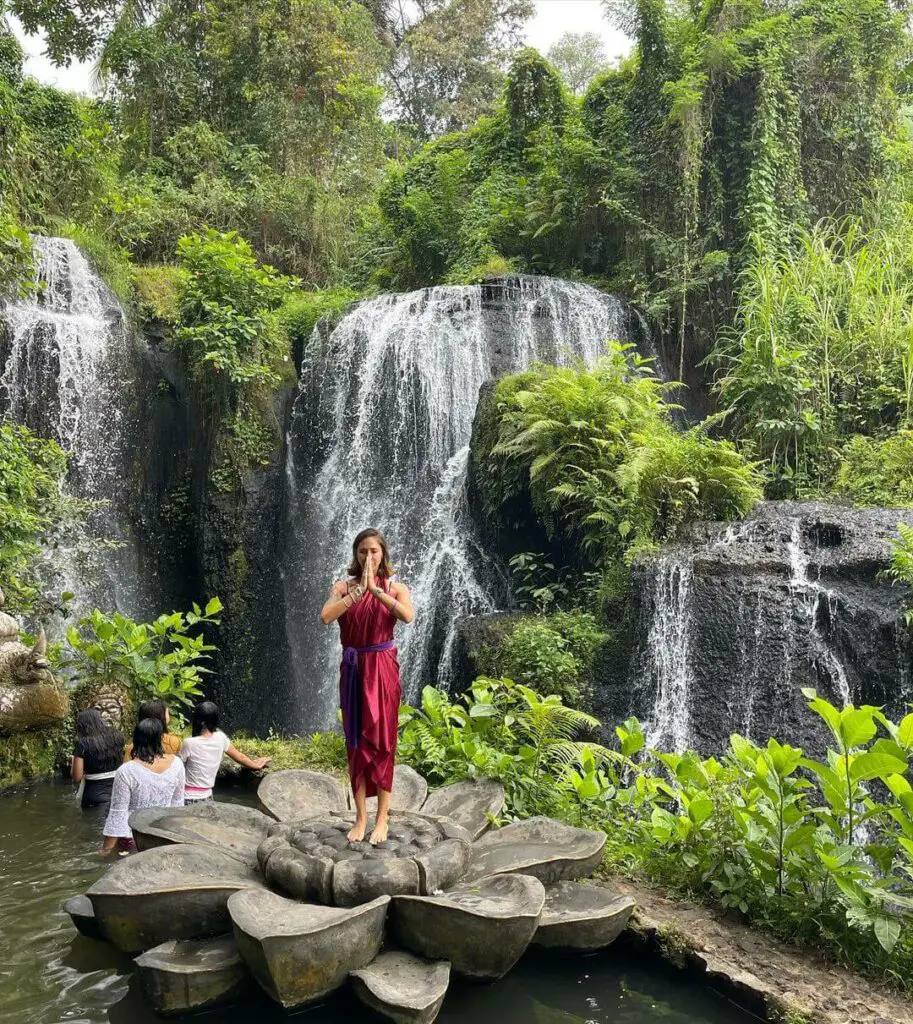
Location: https://maps.app.goo.gl/pHMj9oNEFBp6s9tp6
Beji Griya Waterfall, a relatively recent addition to Ubud’s array of spiritual sites, presents a unique blend of natural beauty and religious significance. Opened in 2022, this temple and waterfall complex is set a short drive west of Ubud. Despite its modern inception, the site has been meticulously designed to mirror the ancient Balinese architectural style, featuring intricate carvings that give an impression of historical depth.
The waterfall itself is a spectacular sight, cascading down amidst lush vegetation, creating a serene and picturesque backdrop. The temple near the waterfall is used for Balinese Hindu ceremonies, adding a layer of spiritual significance to the natural beauty. The Beji Griya Waterfall is not just a visual treat but also a place for spiritual contemplation and connection with nature, offering a unique experience different from the more traditional temples in the area.
Batuan Temple

Location: https://maps.app.goo.gl/CUtqFSniNFrw9pTu9
Batuan Temple, nestled in the village of Batuan between Ubud and Sanur, is a remarkable example of Balinese architectural and cultural heritage. Dating back to the 10th century, this ancient temple is one of the oldest and most significant in Bali. Its well-preserved complex is a showcase of intricate Balinese stone carvings and elaborate temple architecture, offering a glimpse into the island’s rich historical past.
Upon entering, visitors are greeted by an array of meticulously crafted buildings and pavilions, each adorned with detailed sculptures and traditional Balinese motifs. The temple grounds exude a sense of timeless tranquility, inviting contemplation and reverence. Batuan Temple stands as a vibrant center of religious activity and community life, hosting frequent ceremonies and festivals that reflect the spiritual and cultural vibrancy of Bali. For those exploring Ubud’s surroundings, a visit to Batuan Temple offers an authentic and enriching experience of the island’s enduring traditions and artistic excellence.
Taman Ayun Temple
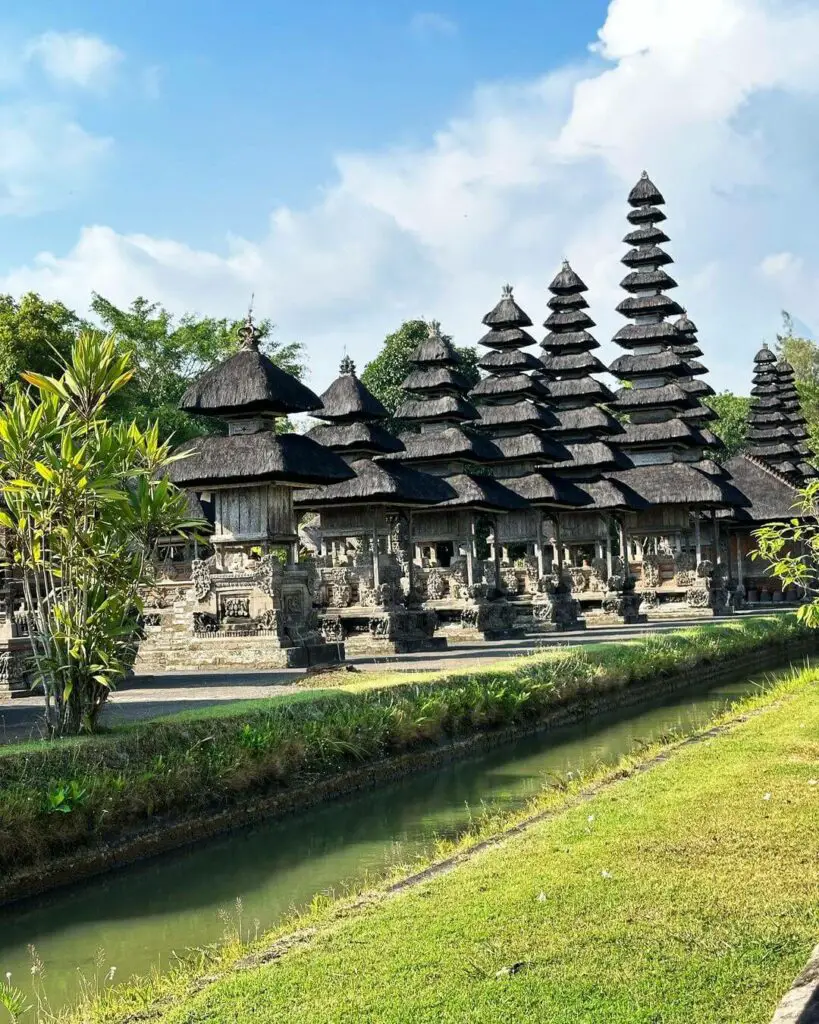
Location: https://maps.app.goo.gl/Tk9pH5ERXZBGppXb9
Taman Ayun Temple, located close to Ubud, is a stunning example of Balinese temple architecture and landscape design, blending spiritual significance with aesthetic beauty. Built in the 17th century, this temple is surrounded by a wide moat, giving the impression of a sanctuary floating on water. The name ‘Taman Ayun’ translates to ‘beautiful garden,’ and the temple lives up to its name with beautifully landscaped gardens and courtyards.
The temple complex is divided into several tiers, each with its own array of shrines and structures adorned with traditional Balinese carvings and statues. The towering tiers symbolize the cosmic levels in Hindu philosophy, leading up to the most sacred area. Taman Ayun Temple is not just a place of worship but also a cultural heritage site, reflecting the artistic and architectural prowess of the Mengwi kingdom. Its serene and picturesque setting makes it a favorite among visitors seeking both spiritual and visual enrichment in Bali.
Pura Taman Pecampuhan Sala
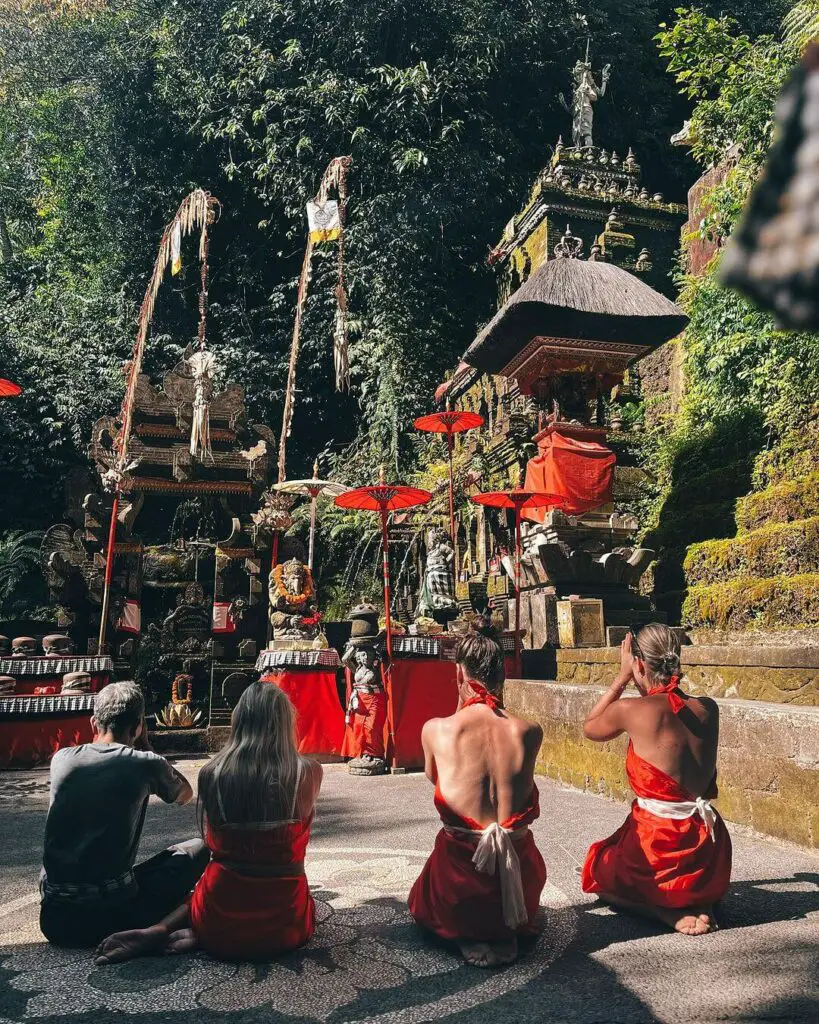
Location: https://maps.app.goo.gl/D2w91RfkvdnDUTSC9
Pura Taman Pecampuhan Sala, situated near Ubud, is a captivating Balinese temple that stands out for its unique combination of natural and spiritual elements. This temple, less known compared to other Ubud temples, offers a tranquil and authentic experience. It is renowned for its picturesque setting that includes a purification pool and a natural waterfall, creating a serene ambiance ideal for meditation and reflection.
The temple architecture is traditionally Balinese, with intricately carved gates and statues that enhance its spiritual aura. The pool, used for ritual purification, is similar to the famous Tirta Empul but with a more secluded and intimate atmosphere. Pura Taman Pecampuhan Sala’s off-the-beaten-path location means it sees fewer tourists, making it an ideal spot for those seeking a peaceful retreat and a more personal connection with Balinese culture and spirituality. The surrounding lush landscapes add to the temple’s mystical charm, making it a hidden gem worth exploring in the Ubud area.







Leave a Reply